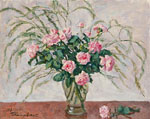
Children in the Garden. 1940
In 1940 the artist writes a series of portraits and, at last, finishes a picture “Pushkin” (he had been writing it for about 8 years).
With the beginning of the Second World War the artist with the family remains in Moscow, and since November, 1941 again comes back to work.
He writes Yumashev’s portrait, this work lasts till January, 1942.
The artist also creates pictures on themes actual for military years (a canvas “Where They render the Blood here?” 1941).

Self-Portrait with Granddaughter (Margot). 1943
1942-1943 M. Lermontov’s portrait is in work.
“While re-reading my Lermontov in a bombproof shelter, I was struck by the idea to write an image of our great poet-patriot. It was just the edition of my father. The memoirs had gushed over me. Being at Caucasus, I often imagined Lermontov at station Kazbek. So I had decided to represent him there and, having made the sketch, I begun to study his portraits, the life and the suits of that time. I had re-read all memoirs about him, and it had helped me to imagine the poet… In July, 1942 I had returned to Lermontov. I again began to re-read his biography, memoirs about him, searching for the brightest moments in his life for a picture.

Lermontov. 1943
I searched for Lermontov’s image in the portraits written from life, in memoirs of contemporaries and, at last, in his poetry. In exile Lermontov has written the remarkable poem “Kazbek” expressing his alarm, his melancholy. Lermontov should appear in my picture almost a boy, proud and happy of recognition, but homesick,.
I have finished “Lermontov” in April, 1943. “
The Curriculum Vitae – p. 5-6.

Spring. Small Yard. 1942
During the war, he also writes three Moscow spring landscapes, three lilacs, three bouquets, two self-portraits, L.I.Tolstaia’s and S.N.Troinitsky’s portraits.

Spring in Moscow. Konushkovskaya Street. 1943
In 1944 the artist carries out sketches and scenery to Bize’s opera “Carmen” for the State Academic Bolshoy Theatre. The work proceeds till 1945.

Still Life. Red Tray and Rowan. 1947
In 1946 he writes a still-life “Oranges and crumpled paper “, devoting this work to P.P.Chistiakov, and creates a conversation – “The Floor Polisher”, written in the exact, confident pictorial manner.

Floor-polisher. 1946
During the second half of 40th years, Konchalovsky writes a plenty of portraits, often of chamber character.
It is possible to note a portrait of surgeon A.A.Vishnevsky (1951) or a long number of portraits of grandsons of the artist, such, for example, as pictures: “Margot dances” (1949), “Andron with a Dog” (1949), “Margot with a Cat” (1948).
He writes also numerous landscapes, pictures concerning to the post-war years with the image of a national life on a background of Russian nature (“After a Mowing” 1948, “Rowing the Hay” 1947,), still-lives (“Field Flowers on a Background of Green Jalousie”, “The Dog Rose on a background of the white tile Oven” , “Wine and Ham”, a long number of “Lilacs”).

Jasmine and Dog-rose near the Oven. 1953
With works of this period the artist summarizes his creative experience, aspires to the synthesis in painting and again starts to write great canvas.

Under the Trees. 1954

Rosettes and Asparagus. 1955

Still-Life. Lilac, Bucket and Watering-can. 1955
In the introductory clause to the catalogue accompanying the Fifteenth personal exhibition of Konchalovsky (1951), Vsevolod Ivanov sums up the previous years of the creativity of the artist: ” Konchalovsky’s creativity has really developed today, and the previous years were only the approach to his present triumph… Konchalovsky’s paints are bright, and in his pictures there is a lot of sun and air, his coloring is unusually juicy, he shows subjects boldly, convexly… P.P.Konchalovsky’s XV anniversary exhibition is an enormous victory of the artist.
To this victory the artist has come, having followed the road of the real sincere serving the people by his art. The author of compositions, the landscape writer, the portraitist, the theatrical artist, the master of still-lives, painting porcelain utensils and samples of tin-plate trays, – everywhere he is the big artist. He loves the life and in the life most of all he is enamored in art… He is the worker regretting every evening, that the day has terminated, “and the hand is not tired yet “; The refined judge of another’s’ works. He is pleased to the occurrence of a new talent and in every possible way helps to promotion of this talent. He is the public figure hotly loving the Soviet native Land and its successes in all areas of the life. Such is Konchalovsky – the singer of flowers, and the sun light “.